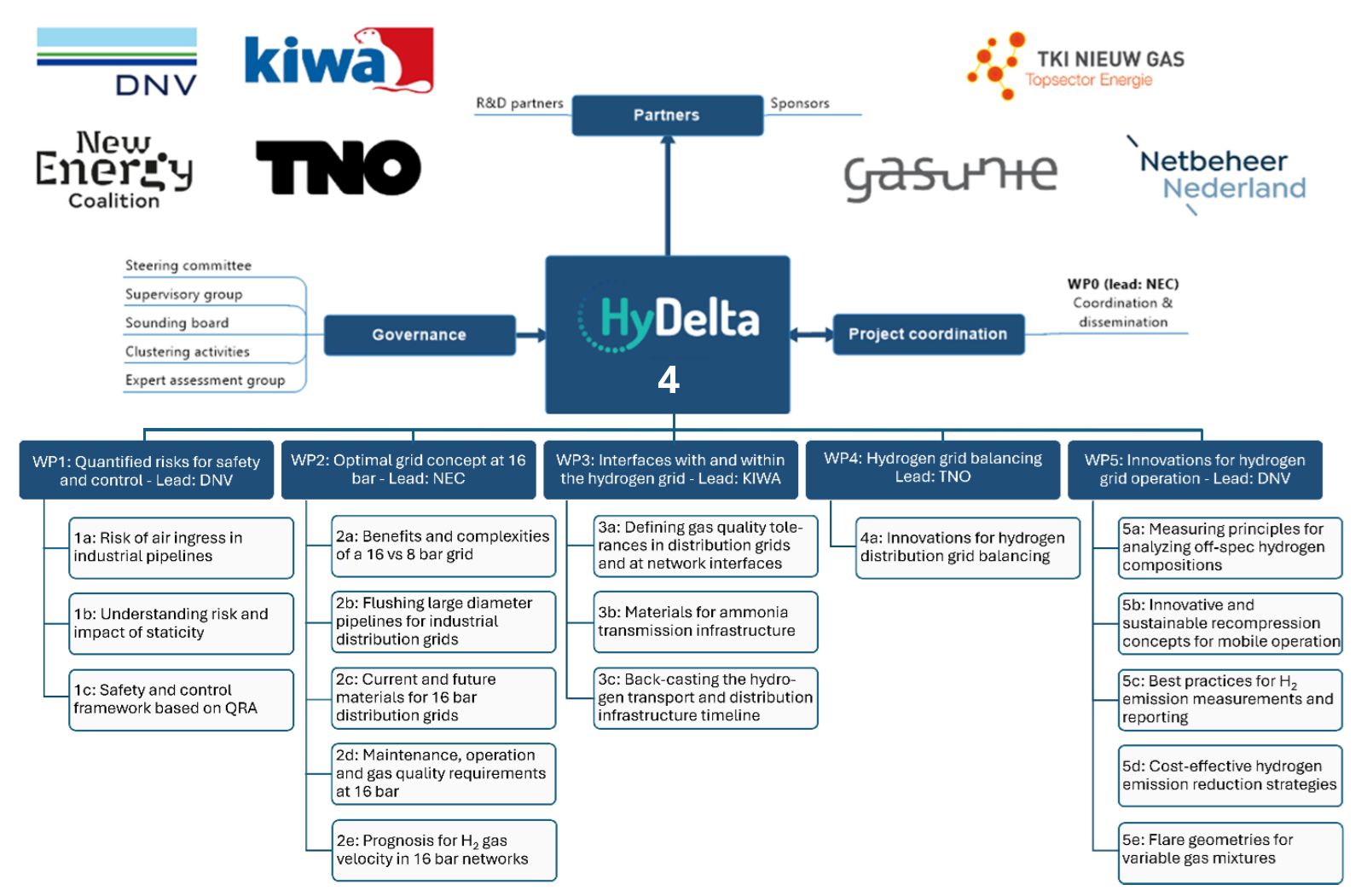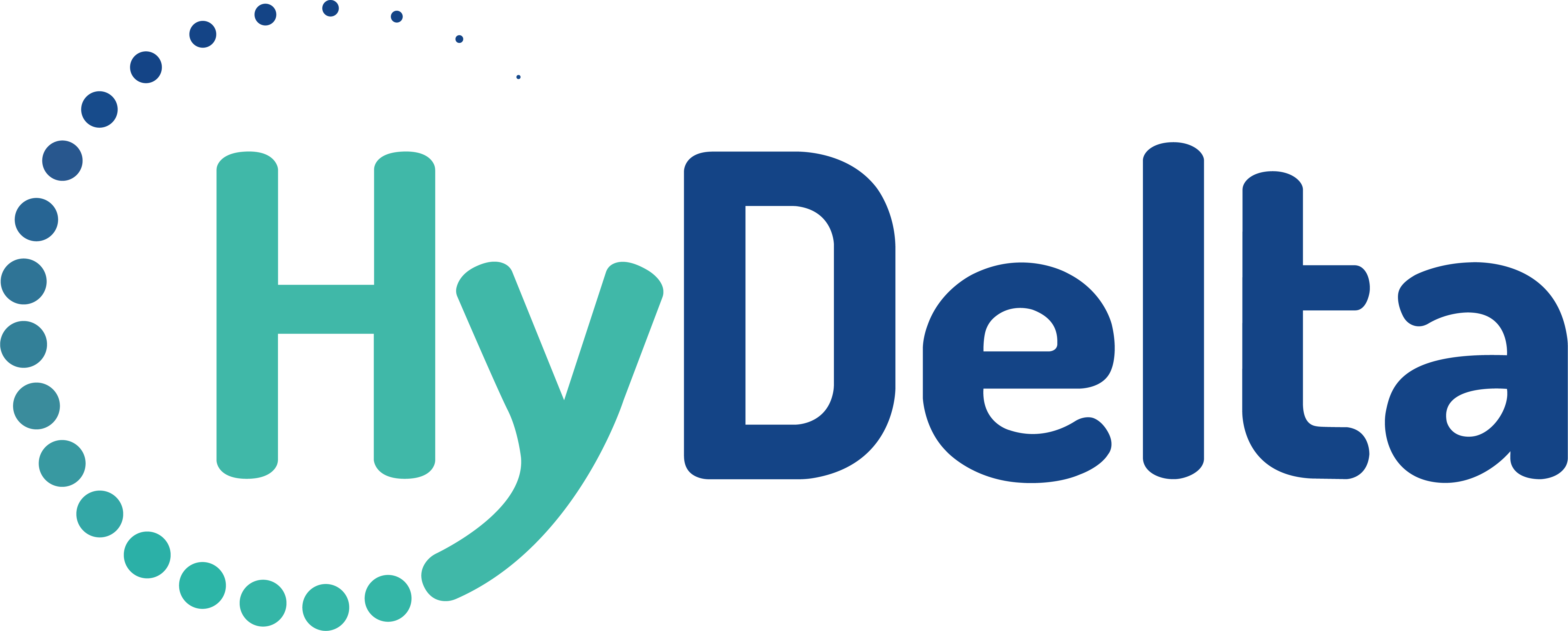HyDelta 4

Research programme
The HyDelta 4 programme is divided into work packages (WPs). Below is an overview of the research topics:
Quantified risks for safety and control
Below is a list of deliverables resulting from the aforementioned work packages, as well as a link to download them (when available):
WP1a: Risk of air ingress in industrial pipelines
Summary: Analysis of ignition risks of a hydrogen/air (or H₂/O₂) mixture in edge cases in an industrial internal pipeline. Potentially unsafe situations are defined, and the effects of possible incidents are mapped out.
| Number | Deliverable title | Publication date | Link |
|---|---|---|---|
| D1a.1 | Relative risks of flammable gas mixtures in industrial pipelines | February 2026 |
WP1b: Understanding risk and impact of static electricity
Summary: Quantification of likelihood of static discharge occurring within a gas distribution network, and likelihood of static electricity ignition near a hydrogen leak.
| Number | Deliverable title | Publication date | Link |
|---|---|---|---|
| D1b.1 | Assessment of internal static electricity and ignition in hydrogen distribution pipelines | February 2026 | |
| D1b.2 | Assessment of external static electricity and ignition in hydrogen distribution pipelines | February 2026 |
WP1c: Safety and control framework based on QRA
Summary: Safety contours and incident mitigation strategies for industrial hydrogen pipelines (8 or 16 bar) and stations, and guidelines for dealing with leaks (incident approach).
| Number | Deliverable title | Publication date | Link |
|---|---|---|---|
| D1c.1 | Safety framework for industrial 8 to 16 bar hydrogen networks | February 2026 |
Optimal grid concept at 16 bar
WP2a: Benefits and complexities of a 16 vs 8 bar grid
Summary: Broad overview of the benefits and challenges of a 16 bar network vs. a previously foreseen 8 bar network, in relation to system design and management, construction and maintenance, guidelines, expertise, organization, and resulting costs.
| Number | Deliverable title | Publication date | Link |
|---|---|---|---|
| D2a.1&2 | Impact of 16 bar hydrogen grids compared to 8 bar hydrogen grids | May 2026 | |
WP2b: Flushing large diameter pipelines for industrial distribution grids
WP2c: Current and future materials for 16 bar distribution grids
WP2d: Maintenance, operation and gas quality requirements at 16 bar
WP2e: Prognosis for H₂ gas velocity in 16 bar networks
Summary: WP2b, 2c, 2d, 2e cover different aspects of a 16 bar network: purging strategies, materials, materials and hydrogen flow speeds. These inputs are incorporated into D2a.2.
| Number | Deliverable title | Publication date | Link |
|---|---|---|---|
| D2b.1 | Purging large-diameter hydrogen pipelines | March 2026 | |
| D2c.1 | Suitable assets and materials for 8 and 16 bar hydrogen grids | September 2025 | |
| D2d.1 | Recommended maintenance and operation for 8 and 16 bar hydrogen grids | March 2026 | |
| D2e.1 | Review of flow speeds and erosion risks in a 16 bar hydrogen grid | March 2026 |
Interfaces with and within the hydrogen grid
WP3a: Defining gas quality tolerances in distribution grids and at network interfaces
Summary: Definition of which hydrogen quality can be guaranteed by regional network operators and how different network segments can be safely and efficiently interconnected.
| Number | Deliverable title | Publication date | Link |
|---|---|---|---|
| D3a.1 | Feasibility of deodorizing hydrogen distribution grids | October 2025 | |
| D3a.2 | Realistic hydrogen specifications in hydrogen distribution grids | January 2026 |
WP3b: Materials for ammonia transmission infrastructure
Summary: Review of requirements for pipelines and materials used in ammonia transport.
| Number | Deliverable title | Publication date | Link |
|---|---|---|---|
| D3b.1 | Overview of materials suitable for an ammonia transport infrastructure | November 2025 |
WP3c: Back-casting the hydrogen transport and distribution infrastructure timeline
Summary: Analysis of the timeline for the realization of hydrogen infrastructure, based on accepted future goals, to help prioritize the development of the different components of the transport and distribution system.
| Number | Deliverable title | Publication date | Link |
|---|---|---|---|
| D3c.1 | Backcasting the 2050 hydrogen infrastructure timeline | October 2025 |
Hydrogen grid balancing
WP4a: Innovations for hydrogen distribution grid balancing
Summary: Investigation of required technologies for network balance protection (e.g., monitoring systems, control systems, IT systems, data communication, etc.), balancing management and settlement (market), and balancing responsibility, mechanism, and roles (regulatory framework).
| Number | Deliverable title | Publication date | Link |
|---|---|---|---|
| D4a.1 | Grid balancing development for hydrogen distribution grids: characteristics and key gaps | September 2025 | |
| D4a.2 | Requirements for the future hydrogen distribution grid balancing systems | May 2026 |
Innovations for hydrogen grid operation
WP5a: Measuring principles for analyzing off-spec hydrogen compositions
Summary: Comparison of current and future technologies for analyzing (off-spec) gas compositions during construction, operation and maintenance in the field.
| Number | Deliverable title | Publication date | Link |
|---|---|---|---|
| D5a.1 | Off-spec hydrogen composition analysis in the field | December 2025 |
WP5b: Innovative and sustainable recompression concepts for mobile operation
Summary: Investigation of best practices in evacuating large pipelines filled with hydrogen without losing significant amounts of gas, focusing on the sustainability of the energy source and emissions management.
| Number | Deliverable title | Publication date | Link |
|---|---|---|---|
| D5b.1 | Functional specification for a sustainable hydrogen re-compressor concept | February 2026 |
WP5c: Best practices for H2 emission measurements and reporting
Summary: Investigation of the applicable (inter)national standards and requirements for equipment and reporting for hydrogen emissions from hydrogen grid operation and maintenance.
| Number | Deliverable title | Publication date | Link |
|---|---|---|---|
| D5c.1 | Best practices for hydrogen emission measurements and reporting | March 2026 |
WP5d: Cost-effective hydrogen emission reduction strategies
Summary: Comparing the efficacy of the various opportunities (or innovation needs) to achieve emission reductions of hydrogen from networks and their interfaces.
| Number | Deliverable title | Publication date | Link |
|---|---|---|---|
| D5d.1 | Emission reduction strategy for hydrogen grids | January 2026 |
WP5e: Flare geometries for variable gas mixtures
Summary: Technological and safety review with best practices for minimizing the release of unburnt gases into the atmosphere by flaring in the case of gas mixtures, created by switching between natural gas, nitrogen and hydrogen during conversion or maintenance.
| Number | Deliverable title | Publication date | Link |
|---|---|---|---|
| D5e.1 | Experimental results on methane/hydrogen gas mixture flaring | March 2026 | |
| D5e.2 | Fluid dynamics modeling results on methane/hydrogen gas mixture flaring | March 2026 |
Dit project is medegefinancierd door TKI Nieuw Gas | Topsector Energie uit de PPS-toeslag onder referentienummer TKI2025-HyDelta
DISCLAIMER: This website as well as the deliverables resulting from the HyDelta project reflect only the respective author’s view

